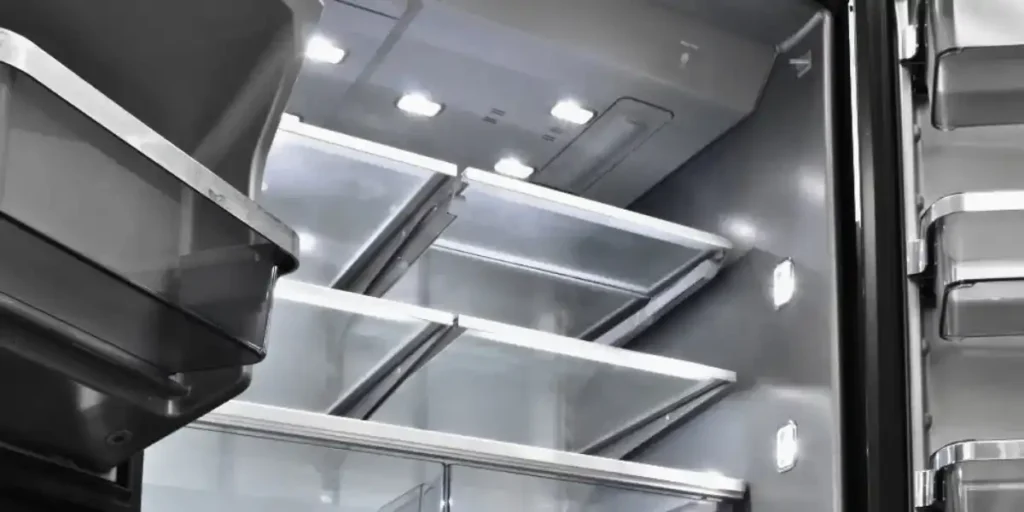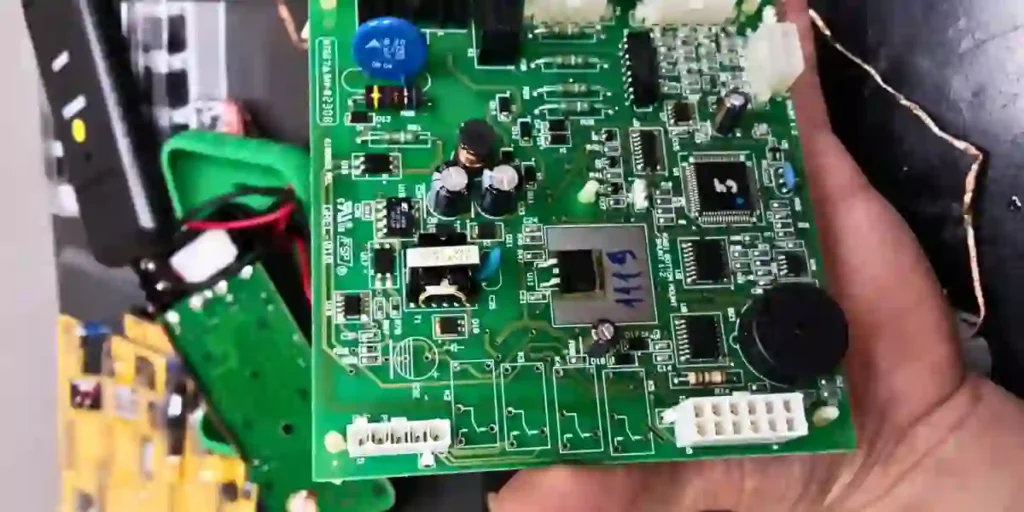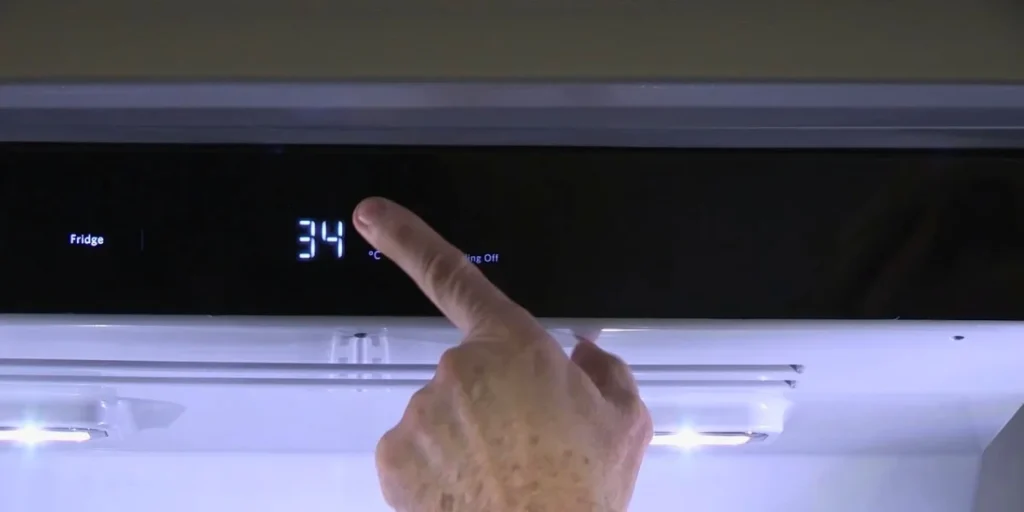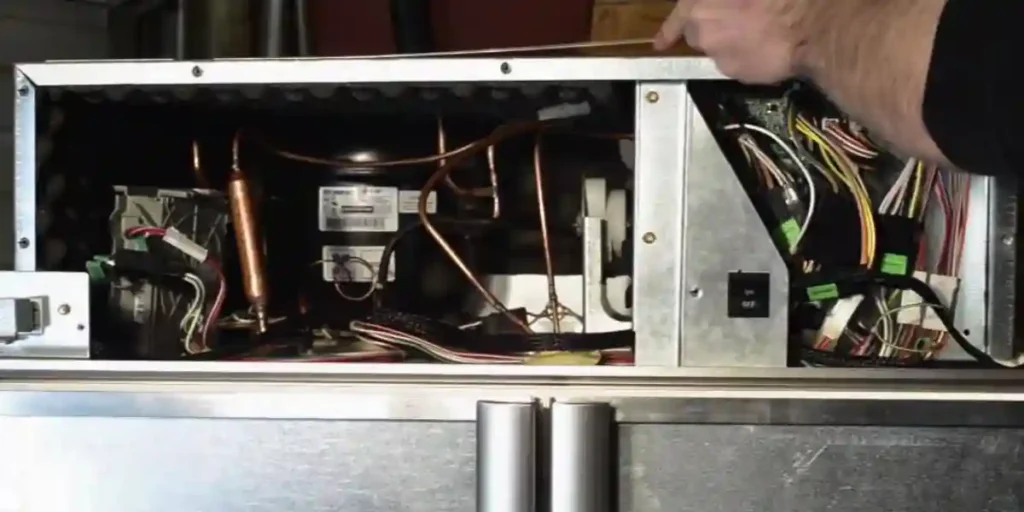Is your KitchenAid refrigerator experiencing flickering LED lights? Wondering why this issue occurs and how to resolve it?
In this article, learn why LED lights on KitchenAid refrigerators flicker and what you can do about it.
Say goodbye to the annoyance and potential risks associated with flickering lights. It’s time to illuminate your KitchenAid refrigerator once again.

Why Are My KitchenAid Refrigerator LED Lights Flickering?
Here are the possible causes and solutions for LED light flickering in your KitchenAid refrigerator.
Loose or Faulty Electrical Connections:
When the LED lights in your KitchenAid refrigerator flicker, the first thing to check is the electrical connections.
Loose or faulty connections can cause intermittent power supply, resulting in flickering lights.
Turn off the refrigerator, unplug it from the power source, and carefully inspect the connections.
If you notice any loose or damaged wires, tighten them or replace them if necessary.
Power Supply Fluctuations:
Fluctuations in the power supply can also lead to flickering LED lights. Power grid problems or issues with your home’s electrical system can cause these fluctuations.
Check if other appliances in your home experience similar flickering issues. A qualified electrician can inspect your electrical system and address any underlying problems.
Defective LED Bulbs:

Defective LED bulbs can cause flickering lights in your KitchenAid refrigerator. Over time, the bulbs may wear out or become damaged, resulting in erratic lighting.
Try replacing the flickering LED bulbs with new ones. Make sure to use bulbs specifically designed for refrigerators and check if the flickering issue persists.
Incompatible LED Bulbs:
Incompatible LED bulbs can also lead to flickering. LED bulbs may not fit into your KitchenAid refrigerator, causing flickering or erratic behavior.
Use the LED bulb recommended by the manufacturer or in the refrigerator’s manual. If necessary, replace the bulbs with compatible ones recommended by the manufacturer.
Temperature Control Problems:
Temperature control issues within your refrigerator can indirectly cause LED lights to flicker.
Flickering lights are caused by excessive temperature fluctuation or a failed defrosting cycle.
Temperature control problems should be diagnosed and fixed by a professional technician.
Electronic Control Board Malfunction:

Your KitchenAid refrigerator’s LED lights can also flicker if the electronic control board malfunctions.
The control board regulates various functions, including the operation of the LED lights. Flickering or inconsistent lighting may result if the control board becomes damaged.
An authorized service center or qualified technician should replace the faulty control board.
How to identify flickering LED lights in KitchenAid refrigerators?
The following steps will help you identify a flickering LED light in your KitchenAid refrigerator.
Observe the Lighting:
Pay close attention to the LED lights inside your KitchenAid refrigerator. Look for any signs of flickering, such as rapid or intermittent changes in brightness.
The flickering may be subtle, so take your time to observe the lighting carefully.
Check for Consistency:
Compare the lighting across all the LED bulbs in your refrigerator. When one or more bulbs flicker while others remain steady, there is a potential problem.
Examine Different Settings:
Watch the LED lights while adjusting the temperature or switching between modes. A flickering pattern that varies or intensifies during certain operations suggests a connection.
Use a Digital Camera or Smartphone:

Take a video of the LED lights flickering with a digital camera or smartphone. If you watch the playback closely, you may be able to see the flickering more clearly.
Perform a Darkness Test:
In a darkened room, open the refrigerator door and observe the LED lights. Any irregular flickering or inconsistent illumination will be more noticeable in a dim environment.
Consult User Manual:
Refer to the user manual of your KitchenAid refrigerator. It may provide specific instructions on how the LED lights should behave under normal conditions.
Compare the manual’s guidelines with the observed flickering to determine if it is abnormal.
Seek Feedback from Others:
Have family members or anyone familiar with your refrigerator observe the LED lights.
Sometimes, different perspectives can help identify flickering that you might have overlooked.
Factors Influencing LED Light Flickering in KitchenAid Refrigerators
LED light flickering in KitchenAid refrigerators is influenced by a number of factors, like,
Voltage Fluctuations:

Voltage fluctuations in the electrical supply can have a significant impact on LED lights.
When the voltage deviates from the standard level, it can cause LED lights to flicker.
Electrical appliances operating on the same circuit or power grid issues can cause fluctuations.
These voltage fluctuations can affect the LED lights in your KitchenAid refrigerator, leading to flickering.
Incompatible LED Bulbs:
KitchenAid refrigerators can flicker if LED bulbs aren’t compatible with the electrical system.
Different LED bulbs have different power requirements and characteristics. Flickering may occur when LED bulbs are not compatible with your refrigerator’s control circuitry.
Temperature Changes:

Indirectly, temperature changes in the refrigerator can cause flickering of the LED lights.
Flickering lights can be caused by extreme temperature variations or a malfunctioning cooling system.
LED lights flicker when temperature control problems disrupt the steady power supply.
Loose Electrical Connections:
Loose or faulty electrical connections can also contribute to LED light flickering. Vibrations or movement of the refrigerator can loosen wires, causing LED lights to stop working.
Flickering is caused by loose connections in wiring harnesses, connectors, or the control board.
Electronic Control Board Issues:
LED lights in your KitchenAid refrigerator are controlled by the electronic control board.
If the control board malfunctions, it can affect the power distribution to the LED lights, causing flickering.
Electrical faults, component failures, or manufacturing defects can affect the control board.
Defective LED Bulbs:
LED bulbs, like any other electronic component, can be prone to defects or failures. If the LED bulbs in your KitchenAid refrigerator are defective, they may exhibit flickering behavior.
This is due to issues with internal circuitry, poor quality control in manufacturing, or handling damage.
Environmental Factors:
Environmental factors can also influence LED light flickering. During severe weather conditions or power outages, your refrigerator may have flickering lights.
A nearby electronic device or appliance can also interfere with LED performance.
How to Avoid Flickering LED Lights in KitchenAid Refrigerators?
Preventing Flickering LED Lights in Your KitchenAid Refrigerators
Use Compatible LED Bulbs:
Ensure that you use LED bulbs specifically designed for your KitchenAid refrigerator. You can determine the recommended bulb type by consulting the refrigerator’s user manual.
Using compatible bulbs reduces the risk of flickering caused by mismatched electrical requirements.
Check Voltage Stability:
Monitor the voltage stability of your electrical supply. Fluctuations in voltage can lead to flickering LED lights.
Regulate the power supply and protect your refrigerator with a voltage stabilizer or surge protector.
Maintain Secure Electrical Connections:

Regularly inspect the electrical connections in your refrigerator. Ensure that all wiring harnesses, connectors, and the control board are securely connected.
Loose connections can cause intermittent power supply, resulting in flickering lights. If you notice any loose or damaged wires, tighten them or seek professional assistance if needed.
Optimize Temperature Control:
Proper temperature control is essential to prevent LED light flickering. The LED lights will not function properly if you frequently open and close the refrigerator door.
Keep your refrigerator’s temperature stable by ensuring the cooling system is working correctly.
Replace Defective LED Bulbs:
If you encounter flickering LED lights despite following the above steps, it may be due to defective bulbs.
Replace any LED bulbs that exhibit consistent flickering or erratic behavior. Purchase high-quality LED bulbs from reputable brands to minimize the risk of defects.
Minimize Environmental Interference:

Reduce environmental factors that can contribute to flickering lights. Electromagnetic interference can cause your refrigerator to malfunction.
Install a backup power source or voltage stabilizer if you experience frequent power outages.
Seek Professional Assistance:
After following all the steps, if the LED lights continue to flicker, you should seek professional help.
Contact KitchenAid customer support or a qualified technician who specializes in appliance repairs.
They can diagnose and resolve complex issues related to your refrigerator’s electrical system.
Frequently Asked Questions About KitchenAid Refrigerator LED Lights Flickering
Can Using Incompatible LED Bulbs Cause Flickering In My KitchenAid Refrigerator?
Yes, using incompatible LED bulbs can lead to flickering. Different LED bulbs have different power requirements and characteristics.
LED bulbs are best suited to the KitchenAid refrigerator’s electrical system and control circuitry.
Can My KitchenAid Refrigerator’s LED Lights Flicker Due To Environmental Factors?
Yes, environmental factors can contribute to LED light flickering. Electromagnetic interference or power grid problems can cause an unstable power supply.
It can affect the performance of LED lights and result in flickering.
Are There Specific LED Bulbs Recommended For KitchenAid Refrigerators To Avoid Flickering?
Use LED bulbs specifically recommended by the manufacturer for your KitchenAid refrigerator model.
KitchenAid customer service or the user manual can provide information about compatible LED bulbs.
Conclusion
Eliminate the frustration of flickering LED lights in your KitchenAid refrigerator. Stabilize voltage, use compatible LED bulbs, and address temperature control issues.
Seek professional assistance when needed. With these steps, you can create an inviting atmosphere while preserving your food’s freshness. Enjoy the brilliance of well-lit refrigeration.
